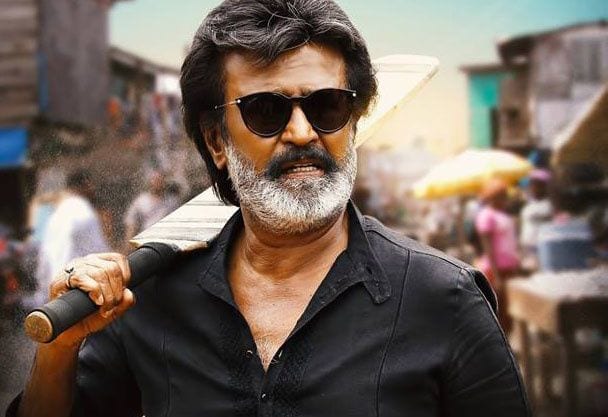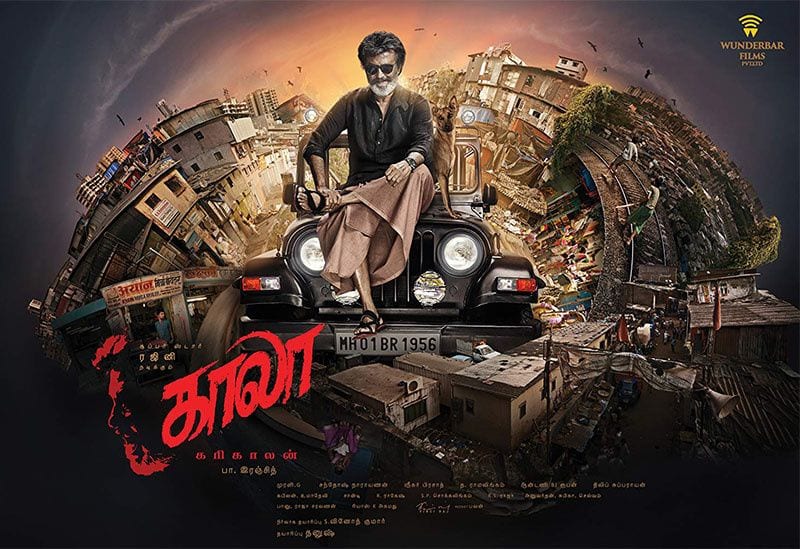
Opinions about Indian cinema’s latest trilingual social drama, Kaala (2018), directed by Pa. Ranjith, India’s Spike Lee, have congested media feeds recently. These coterminous appraisals are dominated by speculations about subversive mythopoeia, national cataclysms, or sub-national identities audio-visually asserted through an aggregation of starpower, symbols, and speech.
Yet, for all the vivid autochthony saturating the film, it is neither parochial nor insular. Kaala‘s protreptic narrative has an au courant global appeal.
The preamble animation, an innovation inaugurated by Kollywood films like Anand Shankar’s Iru Mugan (2016) and Pushkar and Gayatri’s Vikram Vedha (2017), prologues the struggle for territorial control and land authority as the sine qua non of civilization. Thereby establishing Kaala‘s narrative crux and thematic preoccupation: the universal human right to sustainable settlement.
Land grabbers politically connected to a rightwing government besiege a defiant multicultural slum community settled on a prime real estate in India’s financial capital, Mumbai. Dharavi locality’s head honcho, a Tamil businessman-kingpin Kaarikalan, the titular Kaala Seth spearheads a counter-hegemonic opposition.
If in Kabali (2016) director Ranjith invokes history to vindicate those left behind by postcolonial development, in Kaala he screens the geographies of neoliberal capitalism’s victims. Erecting verisimilitude to Dharavi, Asia’s largest slum, cinematographer G.Murali and art director Ramalingam take us through the nooks and cul-de-sacs with gritty authenticity.
The mise en scène is evocative of claustrophobia and entrapment as well as spirited survivalist improvisation. Reminiscent of the Rio De Janiero favelas in Meirelles and Lund’s Cidade de Deus (2002), the Medellin slums in the Netflix series, Narcos (2015), or even the Chennai slums in Mohan Raja’s Velaikkaran (2017), the chawls in Kaala index liminal urban spaces trapped in the limbo of developmentalism.
Having an important character named Lenin, after the father of international revolution whose visage we also see in multiple places, anticipates Kaala‘s internationalism as the first step of synecdochization. The film’s political vision appears inspired by global social justice movements while gesturing towards a universal social condition. Visual quotes, both overt and subtle, abound.
In the home of Kaala Seth’s former lover and NGO social worker Zarina, who returns from work in Brazil and countries in Africa, there is a picture of Nobel laureate Wangari Maathai who protested the Kenyan regime’s attempts to build on Uhuru Park through her Green Belt Movement in the late ’80s and early ’90s.
Shantytown dwellers protesting against eviction in Kaala borrow the slogan: ‘No Land! No House! No Vote!’ from the national campaign by the South African Landless Peoples Movement.

Foregrounding Dharavi’s hip-hop culture as the slum’s vox populi is just one vestibule. Allusions to African and African-American culture seen in both Kabali – structurally inspired by Quentin Tarantino’s Django Unchained (2013)– and Kaala bear the authorial inscriptions of an Afrophile director.
Ranjith openly declared his adulation for Ryan Coogler’s Black Panther (2018) on Twitter after watching the film. Like India’s Dalit Panther party inspired by the Black Panther party in the United States, once or twice, paeans even refer to Kaala Seth as a black panther.
There is even the abstruse reference to Palestinian stone-throwing, which is similarly met with asymmetrical violence from the powerful in Kaala. Ascribing homage to the visual collusion retrieves undercurrents of solidarity. After all, Tamil social activist and political leader E.V.Ramasamy (1879-1973) did refer to the Palestinians as “Arab Dravidas”, claiming common cause between the postcolonial struggles of South Indians and Palestinian Arabs.The cumulative effect of these appeals to universalism in Kaala‘s agitprop is to deconstruct the forces of rightwing illiberalism in ways hitherto unseen in Indian cinema. Exploiting the precariat of the Dharavi chawls for their own hegemony-building benefit are a Saffron political party ergo upper caste Hindu neo-fundamentalism.
The party’s chief and demagogue is also the film’s antagonist, Haridev Abyankar or Hari Dada, for whom Kaala Seth is bête noire. The Saffron party’s acronym, NNP, may very well be a backronym for ‘neo-nationalist party’.
Neo-conservatism is laid bare as nothing more than the coupling of fascism with criminal crony capitalism behind the veil of patriotism. The Saffron party workers double as shock troops to manipulate the anxieties of the urban poor in order to expropriate land for profit and if necessary, forcefully confiscate it.
Hari Dada’s sly demands to supplicate his ego by prostrating before him imply submission to his power, as well as subordination to majoritarian hegemony. Exclusion and intolerance underscore the Saffron party’s brand of identity politics. Contrarian voices and actions are lynched.
There are stark resemblances between Hari Dada and authoritarians elsewhere with his cult of personality, political repression, and rapacious privatization. He constitutes a Machiavellian conflation of reactionary populist strongmen who now hold the highest office in some of the world’s biggest democracies and the most powerful states in the international system. Führerprinzip and personenkult aside, like them, he preys on feelings of precariousness, resentment, and desperation to marginalize minorities, increase the surveillance from the state, and amass extralegal powers.
The proprietor of the construction firm Manu Realty, Hari Dada also wants to implement a neoliberal capitalist agenda. Slums housing the landless working classes, once derided with pinched noses, become a post-liberalization bonanza to be plundered. Slum residents are lured by advertisements, with images of Caucasians from suburbias in the West, and tempted with promises of spacious apartments with toilets, golf courses, stadiums, hospitals, and colleges to sign over their land rights.
Yet, everyone will be evicted but only some will be shoehorned into overcrowded microflats, a far cry from what they were promised. The predations of the Saffron party exacerbate the landlessness of the urban poor.
Hari Dada’s Messianic (he believes he was ‘born to rule’) proclamation to usher in a ‘clean and pure’ utopia in exchange for political power is a classic rightwing populist ploy. Grandiose pledges of revitalizing national luster end up crippling democracy. Made in a time of growing illiberalism across the international community, Kaala‘s message is timely.
However, if we are to believe Kaala‘s hortatory, the slide to a permanent democratic recession is not inexorable. In order for any political struggle against the Far Right to reach an entelechy or most intense levels of politicisation, a radical new counterculture must be unleashed.
By resurrecting forces from the Left of the political spectrum, thought to be dead and buried, militating impulses can be harnessed and vanguarded into a campaign for genuine grassroots agitation instrumentalized by social media’s technodemocratic possibilities.
Teleologically in Kaala, this new movement synthesizes ideas from indigenous and transnational strands of progressive Left-liberal thought. Goals of secularism, affirmative action, rationalism, egalitarianism, social reform, and class-consciousness, accompanied by mobilization are necessary to defenestrate ultranationalist populist strongmen, as evident in Kaala‘s revolutionary denouement.
The confluence of political thought symbollized in hues that engulfs Hari Dada at the end – black for the aforementioned E.V. Ramasamy’s egalitarian movement, blue for India’s first Law Minister and Dalit activist B.R. Ambedkar’s principles, and red for Marxism – will provide the ideological foundations for this raised collective consciousness.
Rolling back rightwing populism around the world and reviving the global Left will require a nostrum amalgamating autochthonous political thought with transnational variants we are told.
While this New Counterculture can have a mascot, the cryptic climax of Kaala reminds us that the collective must transcend the leader. As Kaala Seth Indian cinema’s ‘superstar’ Rajinikanth is reminiscent of his character Suri from V. C. Guhanathan’s cult classic Thanikattu Raja (1982), a Che Guevaraesque angry young revolutionary, who rejects the mantle of leadership and any hint of a personality cult for a democratic crusade of the peasantry against corrupt rural politicians.
Likewise, Kaala Seth obviates himself by the end of the film to allow the microinsurgency to gain its own momentum. The relentless regeneration of severed heads from a Hindu folktale is given a mythoclastic twist as an analogue for an unstoppable mass movement or even human waves in revolutionary conflict.
Of course, we are left with the question of what comes after the revolution. Kaala only has a panacea for forestalling the surge in autocratic predilections. What would supplant the despotism remains to be seen. The meaning of a well-functioning secular socialist democracy is never fully articulated.
The furthest extent of Ranjith’s pop-pamphleteering is to foment revolution on screen and permit vicarious catharsis in the vanquishing of tyranny. We are told that resistance to ‘land expropriation without compensation’ springs across India’s major cities – but what after that? Ranjith might want to take a cue from Coogler’s resolution of ideological tension in Black Panther.
Neither is Kaala an epic. It is episodic and disjointed in that we are never fully allowed to empathize with characters because there are so many seemingly important characters but they never grow on us. Indeed, this narrative is, unfortunately, bloated.
Apart from the melodramatic confrontations between Kaala Seth and Hari Dada, numerous other conflicts erupt and diffuse too rapidly for us to be truly invested in it. Better editing may have helped some of the film’s early drag.
Let us be clear, as far as political cinema goes, Kaala is no Battleship Potemkin (1925), or Battle of Algiers (1966), or even an Oru Indhiya Kanavu (1983) or Kann Sivanthaal Mann Sivakkum (1983).
Nevertheless, Kaala has its whistleblowing moments that ignite one’s inner social justice warrior and inspire hope in a truly political liberal hereinafter. Besides, if history suggests that cultural transformation must be anterior to political revolutions, masscult is an apt conduit.
Only time will tell if pop-pamphleteering can have an incendiary effect in a time of growing illiberalism. Wasn’t it the real Lenin who asserted: “Of all the arts, for us the cinema is the most important”?



